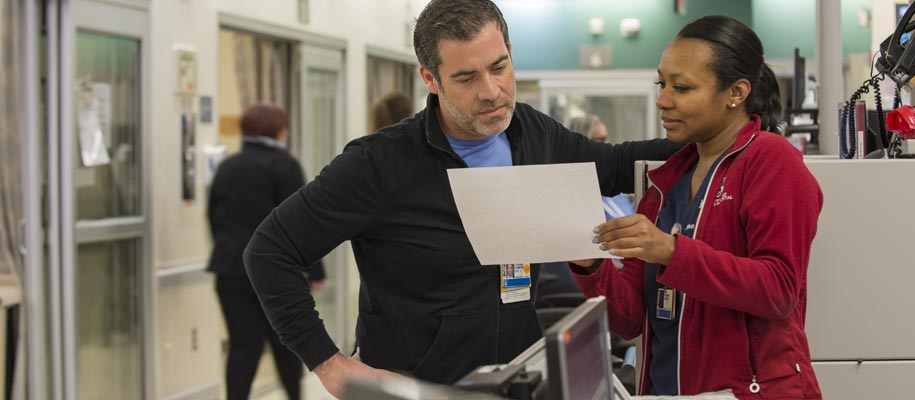
Emergency Department nurses at Brigham and Women’s Hospital are influencing improvements to enhance efficiency, reduce wait times, and create a more comfortable, healing environment for patients and families. Given nurses’ many touchpoints with patients, while also immersed in the logistical challenges of a busy Emergency Department (ED), they have a unique vantage point to drive key innovations in plans for a patient-centered expansion.
“The nurses have been involved in every aspect of the new space,” said the ED’s executive director Janet Gorman, MM, BSN, RN. The 30-bed expansion, expected to begin this summer, will double the size of the current ED and add state-of-the-art trauma rooms and distinct spaces for behavioral health and oncology patients.
As plans for the new ED took shape, nurses on the front line of emergency medicine were influential in improving patient flow and inefficiencies. They continually asked, “How can we eliminate unnecessary wait times?” and offered solutions.
Their input is evident. Plans for the new department include better sight lines between staff and patients and consistent layout of all patient care areas so that supplies and equipment are predictably in reach. Stretcher placement was altered after nurses pointed out that the initial plan impeded access. New hands-free communication devices are being tested in the current ED, with the expectation that they will ease and speed communication among nurses in the larger space.
One important feature that is already underway in the current ED is a new system to minimize “walkouts” that occur when patients opt to leave before seeing a physician during busy periods. BWH nurses knew from studies that these patients tend to be just as sick as those who remain for treatment, and it bothered them.
“Knowing that some patients were leaving without needed care made us want to do better,” said Gorman. “And we have.”
A multidisciplinary team tackled the problem by transforming non-clinical ED spaces that were used to see patients only during high-volume periods into a regularly-staffed area for patients whose needs (such as stitches or lab tests) could be addressed quickly.
The impact was immediate and dramatic. The walkout rate dropped to less than one percent and has been sustained. Incorporating more flexible spaces that can be adjusted with fluctuating ED patient volume are also part of the expansion plans.
But nothing was more important to the ED’s nurses than improving patient privacy. They advocated successfully to replace curtained treatment areas with private, walled rooms for all patient care and sensitive communications.
Other aspects of the expansion are small but important touches to make patients more comfortable during an unsettling timeNew patient rooms will be more patient- and family-centered, with accessible outlets to charge phones, plenty of seating, and softer lighting (controlled by patients) that creates a more restful environment.
“It’s those simple little things that mean a lot to patients,” said Gorman.
Nurses’ influence and innovation – from small human touches to large-scale logistics – are all contributing to improved care and patient experience in an expanding ED.